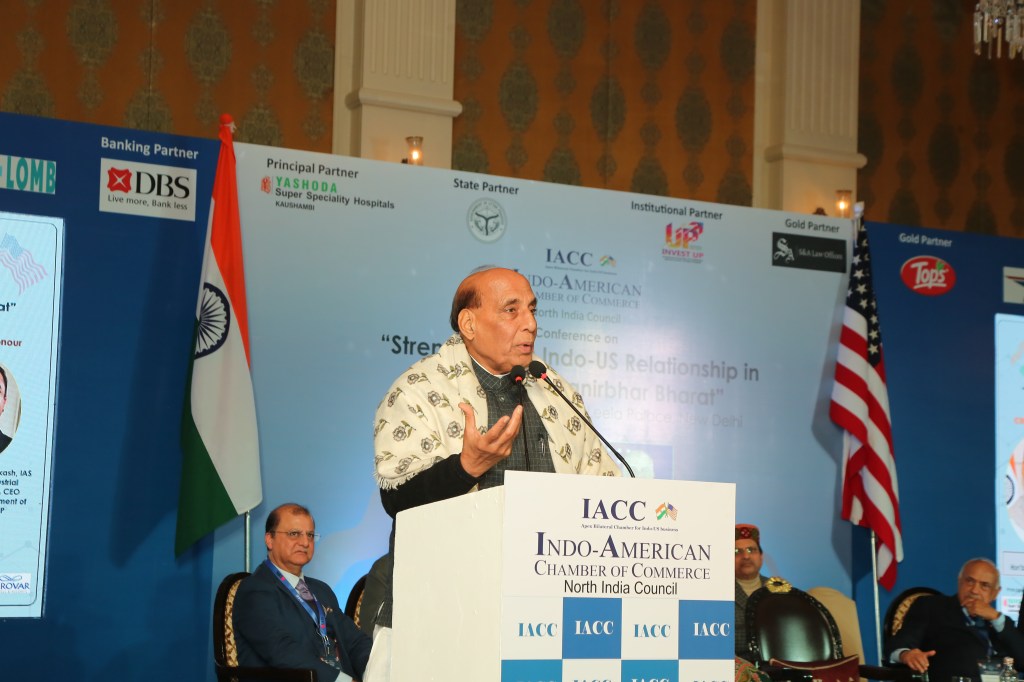In a groundbreaking event that took place on January 30, 2024, in New Delhi, India, Defence Minister Rajnath Singh addressed a conference organized by the Indo-American Chamber of Commerce (IACC) on ‘Strengthening Indo-US Relationship in Amrit Kaal – Aatmanirbhar Bharat.’ This conference marked a crucial milestone in exploring and solidifying the collaboration between India and the United States across various domains.
Singh’s keynote speech resonated with the idea that the synergy of American capital and technological expertise could be the driving force behind India’s ambitious goal of achieving developed country status by 2047. He envisioned a mutually beneficial scenario where American investments not only yield high returns but also provide a strategic avenue for de-risking in the face of evolving global challenges.
Underlining the meticulous groundwork laid by the Indian government for a strong and self-reliant ‘New India,’ Singh positioned American investments as a cornerstone in realizing Prime Minister Narendra Modi’s visionary ‘Viksit Bharat.’ This collaboration, he emphasized, embodies a win-win situation, leveraging India’s fast-growing economy, demographic dividend, skilled workforce, and vast domestic market to the advantage of US companies.
Singh highlighted the imperative for American businesses to de-risk amidst challenges to the rules-based international order, asserting that investing in India is not just an opportunity but a necessity. He painted a compelling picture of India and the US as natural partners, not only in economic ventures but also in navigating the complexities of the current global geopolitical scenario. According to Singh, the commitment to a free, open, and rules-based international order forms the bedrock of their strategic alignment.
The defence minister acknowledged the ongoing collaboration in critical fields such as defence technology and space, citing initiatives like the Defence Technology and Trade Initiative and the joint ISRO-NASA project ‘NISAR.’ These initiatives symbolize the commitment to cooperation in areas like earth science, disaster management, and climate change, showcasing the diverse facets of their partnership.
In Singh’s perspective, the collaboration of the two largest democracies is not merely advantageous for them but serves as a force multiplier for the democratic world order. He expressed confidence that their joint efforts would not only benefit both nations but also contribute positively to the entire world.
Expanding on the government’s vision encapsulated in ‘Aatmanirbhar Bharat,’ Singh clarified that it is not about isolation or autarky but emphasizes collaboration with friendly nations. The campaign, he stressed, promotes companionship based on the profound concept of ‘Vasudhaiva Kutumbakam’ (The World is One Family).
The conference, attended by distinguished figures like Ambassador to India Eric Garcetti and representatives of IACC, aimed to strengthen economic and diplomatic ties between India and the US. It sought ways to enhance bilateral trade, investment, and collaboration within the broader framework of the ‘Aatmanirbhar Bharat’ initiative, placing particular emphasis on promoting domestic manufacturing and reducing import dependency.
Ambassador Eric Garcetti characterized the Indo-US relationship as a ‘multiplicative relationship,’ underscoring its transformative potential. He expressed the US’s desire for increased investments in India, acknowledging certain obstacles such as opaque corporate tax practices. Garcetti urged companies to explore the vast opportunities in India, citing the eagerness of CEOs to invest in the country.
While acknowledging the shift in foreign direct investments (FDI) towards Southeast Asian countries, Garcetti expressed the hope for FDI to flow from China to India. He called for changes in export policies for both nations to align with their mutual goals, emphasizing the need to dismantle bureaucratic, taxation-related, and regulatory barriers for enhanced economic cooperation.
Garcetti envisioned India becoming a larger trade partner for the US, drawing parallels between India’s potential and success stories like the iPhone. He commended India’s manufacturing prowess and anticipated similar achievements with companies like Tesla, underscoring the growth in employment resulting from the strengthening ties between the two nations.
